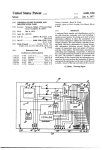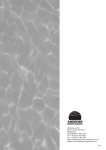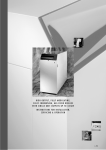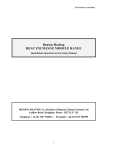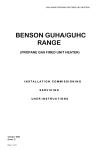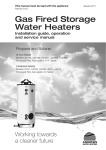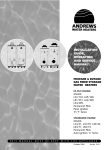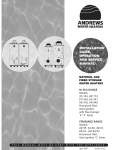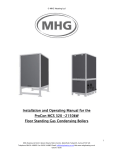Download Alpha 700 Technical data
Transcript
ALPHA70 CAST IRON SECTIONAL OIL, GAS & DUAL FUEL BOILERS SINGLE UNIT OUTPUTS 295kW - 640kW I N S T R U C T I O N S F O R A S S E M B LY / INSTALLATION, SERVICING & OPERATION ALPHA 700 contents page section 3 . . . . . . . . . . .1.0 2.0 General Notes Product Description 4 . . . . . . . . . . .3.0 Key Points 5 . . . . . . . . . . .4.0 5.0 Specification for Alpha 700 Delivery 6 . . . . . . . . . . .6.0 7.0 Single Boiler Dimensional Data/Clearances Installation Requirements 7 . . . . . . . . . . .8.0 9.0 10.0 Air Supply & Ventilation Boiler Base Clearances 8 . . . . . . . . . .11.0 Technical Data 9 . . . . . . . . . .12.0 13.0 System Schematic Using Reverse/Return System Schematic Using Diverter Valves 10 . . . . . . . . .14.0 15.0 16.0 Minimum Water Flow Rate Circulating Water Flue Systems 11 . . . . . . . . .17.0 Control Panel 12 . . . . . . . . .17.0 Standard Boiler Control Panel Electrical Diagram 13-17 . . . . . . .18.0 18 . . . . . . . . .19.0 System Connections 19 . . . . . . . . .20.0 21.0 22.0 Mounting The Burner Controls Commissioning Procedures 20 . . . . . . . . .23.0 24.0 Initial Lighting Adjustment & Safety Checks 21 . . . . . . . . .25.0 Boiler Servicing 22 . . . . . . . . .26.0 27.0 To Turn On The Appliance To Turn Off The Appliance 23 . . . . . . . . .28.0 Fault Finding 24-25 . . . . . . .29.0 2 Boiler Installation Boiler Log 26 . . . . . . . . .30.0 Service Repair Record Sheet 27 . . . . . . . . .31.0 Spare Parts ALPHA 700 1.0 general notes These instructions are intended to assist the installer, commissioning engineer, maintenance engineer and user with the assembly, installation maintenance and operation of the Alpha 700 Series Cast Iron Sectional Boilers and must be read in conjunction with the instructions supplied with the burner. Please read this manual fully before commencing the installation of the boiler. This manual must be handed to the appliance user following completion of the installation. If the Alpha 700 boiler is to be gas fired, then the installer must be deemed to be competent in the relevant areas of gas work involved and be Corgi Registered for those areas. 2.0 product description The Alpha 700 Series of cast iron boilers are engineered to the highest standards of design and production quality, performance and reliability. The range comprises nine models offering LTHW outputs from 295 to 640 kW. Each boiler is supplied with a matched Natural gas, LPG, Oil or Dual Fuel Burner. The boilers are supplied in kit form for on-site assembly, thus allowing greater ease of handling and reduced difficulties where plant room access is restricted. 3 ALPHA 700 3.0 key points conformity with standards All Alpha 700 series boilers are designed and manufactured in accordance with the requirements of EN 303.1 and are supplied with burners certified to the relevant standards. Alpha 700 series boilers are CE approved and conform to all relevant standards and requirements. 68AR139 quality Alpha 700 burners are manufactured under a quality system in accordance with Quality Assurance ISO 9001. high output The boiler heat exchanger has been designed around the turbo rotation principle of turbulent flow of flue gases through the flueways giving excellent heat transfer properties. The Alpha 700 series provides outputs from 295kW to 640kW, with the use of 8 through to 16 sections. fuel options Each boiler is supplied with a perfectly matched power flame burner. The user has freedom to choose from natural gas, LPG or class D oil. With a quick burner changeover, or with the use of a dual fuel burner, there is no need to be locked into any single fuel, allowing the use of the most economical fuel. reduced emissions The combustion chamber and flueways are of large volume and this, coupled with the principle of flue gas flow employed and power flame combustion, significantly reduces un-burnt particles and harmful oxides, protecting the environment from higher levels of damaging pollution. built to last The exceptional corrosion resistant properties of the casting material in conjunction with the unique polygonal profile of the combustion chamber combine to create a boiler body that will withstand the rigours of heavy duty. The combustion chamber walls are designed to allow convex flexing, giving the inherent strength of resistance to mechanical and thermal movement. reduced maintenance The turbo rotational passage of the flue gases through the generous sized flueways ensures low potential for fouling with combustion deposits. In addition, the entire front of the boiler body is a hinged access door providing easy and generous access for cleaning and inspection, reducing maintenance time. low standby losses The use of burners with fully closing air inlet dampers, and a high standard of insulation, keeps standby and maintenance losses to a minimum within the range 0.3 to 0.5%, conserving energy and reducing plant room temperatures. guarantee Heat exchanger carries a five year guarantee against material or manufacturing defect. 4 ALPHA 700 4.0 specification for Alpha 700 The three pass heat exchanger is constructed using high carbon content corrosion resistant cast iron sections with turbo rotational flue passes and polygonal profile combustion chamber. The assembled body is connected together using biconical nipples and full length tie rods. Gas tight sealing of the sections, one to another, is achieved using ceramic fibre rope bedded into channels in the casting faces. The rear of the combustion chamber includes an anchored ceramic target wall. The combustion chamber is fully water cooled and is spaced generously above floor level to ensure low boiler house floor temperatures. The boiler is suitable for a maximum flow temperature of 95°C and a maximum working pressure of 5.5 bar. combustion chamber door The combustion chamber door covers the entire front of the boiler body, providing uncompromised access to the combustion chamber and horizontal flueways, allowing total front cleaning with the robust cleaning tools provided. The door is hinged on both left and right hand sides giving freedom of choice for handed opening without the need to move hinge positions. The door is heavily insulated with dense ceramic fibre panels which reduces heat loss and thermal inertia. insulation The boiler body is insulated on all faces with a dense fibre-backed insulating blanket of 100mm thickness. casing Each boiler is provided with a high quality rigidly attached stove enamelled casing. control panel Each boiler is supplied with a fully pre-wired top mounted control pod which incorporates high and low fire control thermostats, manual reset high limit thermostat, water temperature thermometer, burner on/off switch, pump on/off switch, high limit thermostat test button, high and low fire hours run counters, fascia mounted fuse holder and lamps to indicate low fire, high fire, power on, high limit trip and burner lockout. As an option, volt free contacts may be included to relay status information to a BMS or similar remote monitoring panels. 5.0 delivery item 1 Pallet(s) of boiler sections complete with accessories. item 2 Pack of tie rods. item 3 Carton containing casing and insulation. item 4 Selected burner and burner accessories. item 5 Carton containing control panel. 5 ALPHA 700 6.0 single boiler dimensional data/clearances 430 1020 B A 165 1765 1600 øD 1135 1410 530 C 555 102 Dimensions in millimetres Models Alpha 700 300 340 380 425 470 510 555 600 640 A - Overall Length - mm 1515 1650 1785 1920 2055 2190 2325 2460 2595 B - Casing Length - mm 1360 1495 1630 1765 1900 2035 2170 2305 2440 C - Section Length - mm 1030 1165 1300 1435 1570 1705 1840 1975 2110 D - Flue Outlet Size - mm 300 300 300 300 300 300 300 300 300 Flow & Return Connection DN100 DN100 DN100 DN100 DN100 DN100 DN100 DN100 DN100 7.0 installation requirements The Alpha 700 series boilers must be installed in accordance with (as appropriate) the requirement of the Building Regulations, Health and Safety Executive Regulation PM5, IEE Regulations, Gas Safety (Installation and Use) Regulation, National Water Bylaws, Clean Air Act Memorandum on Chimney Heights and any Insurance Company requirements. codes of practice BS 6880 BS 5410 BS 6644 IGE/UP/2 CISBE Guide LPG 6 Code of Practice for low temperature hot water heating systems for output greater than 45kW, Parts 1, 2 and 3: 1988. Part 2: 1978 - Code of Practice for oil firing installations of 44kW and above output for space heating, hot water and steam supply purposes. 1991 - Specification for installation of gas fired hot water boilers of rated inputs between 60kW and 2MW. Gas Installation pipework, boosters and compressors on industrial and commercial premises. Reference sections B7, B11 and B13. When boilers are fired with LPG, it is recommended that gas leakage detection equipment is installed at low level, near the boiler or boilers. ALPHA 700 8.0 air supply & ventilation An adequate supply of fresh air for combustion and ventilation of the boiler house must be supplied in accordance with BS6644/BS5410 as appropriate. The air supply should be achieved using: a) Natural ventilation with low level and high level openings. b) Using a fan to supply air to a low level opening with natural discharge through a high level opening. c) Using a fan to supply air to a low level opening and a fan to extract air at a high level opening. Where natural ventilation is used, suitable permanent openings connected directly to the outside air must be provided. The openings should be fitted with grilles that cannot be easily blocked or flooded. The free area of the grilles should be as follows:LOW LEVEL (inlet) 540cm2 plus 4.5cm2 per kW in excess of 60kW of total rated input. HIGH LEVEL (outlet) 270cm2 plus 2.25cm2 per kW in excess of 60kW of total rated input. 9.0 boiler base plinth details ≈10cms Alpha boilers should be installed on a level fireproof plinth with a minimum height of 100mm. The plinth must be capable of supporting the weight of the boiler/s when they are filled with water. The front of the plinth can be level with, but not extend beyond, the front of the boiler casing. Depending on the make of burner selected, dual fuel applications may require a higher plinth. Details will be provided on request. A B Plinth must be level and trowelled smooth. Alpha 700 300 340 380 425 470 510 555 600 640 A cm 136 150 163 177 190 204 217 231 244 B cm 112 112 112 112 112 112 112 112 112 10.0 clearances The dimensions shown below are required for proper access for assembly and maintenance. There is no requirement for clearance above the boiler. 1000 min X 1000 X + 200 Dimension X in mm Gas Oil Dual Fuel 300 580 470 610 340 580 470 610 380 580 470 770 425 580 470 770 470 580 470 770 510 580 470 770 555 840 680 920 600 840 680 920 640 840 680 920 (450 min) 450 min Model 7 ALPHA 700 11.0 technical data Boiler Model Max Heat Output to Water Alpha 700 300 380 425 470 510 555 600 640 kW 295.3 338.4 381.4 424.4 467.4 510.4 553.5 596.5 639.5 Btu/h x 1000 1007.5 1154.6 1301.3 1448.0 1594.7 1741.4 1888.5 2035.2 2181.9 kW 327.8 375.5 423.3 471.0 518.8 566.5 614.3 662.0 709.8 Btu/h x 1000 1118.4 1281.2 1444.2 1607.0 1770.1 1932.8 2095.9 2258.7 2421.8 Water Content L UK Gal 272 59.8 302 66.4 332 73.0 362 79.63 392 86.22 422 92.8 452 99.4 482 106.0 512 112.6 Design Flow Rate L/sec ∆t10°C ∆t15°C ∆t20°C 7.03 4.68 3.51 8.05 5.37 4.02 9.08 6.05 4.54 10.1 6.73 5.05 11.1 7.41 5.56 12.1 8.1 6.07 13.1 8.78 6.58 14.2 9.46 7.10 15.2 10.15 7.61 Waterside Pressure drop mm wg ∆t10°C ∆t15°C ∆t20°C 120 60 30 155 80 38 200 100 50 250 125 62 300 150 75 360 180 90 420 210 105 490 245 122 560 280 140 3.51 4.02 4.54 5.05 5.56 6.07 6.58 7.10 7.61 95 95 95 95 95 95 95 95 95 Max Heat Input (Nett) Minimum Flow For L/sec Shunt Re circulation Maximum Flow Temperature °C Maximum Working Pressure Bar 5.5 5.5 5.5 5.5 5.5 5.5 5.5 5.5 5.5 psig 79.75 79.75 79.75 79.75 79.75 79.75 79.75 79.75 79.75 Input Rate 35SRI Oil L/h UK Gal/h 34.01 7.48 38.96 8.57 43.92 9.66 48.87 10.75 53.82 11.83 58.77 12.92 63.73 14.01 68.68 15.10 73.64 16.19 Approx Flue Gas Volume at NTP Oil Fired m3/h 463.2 530.7 598.2 665.7 733.1 800.5 868.1 935.5 1003.1 ft3/h 16,357 18,741 21,125 23,509 25,890 28,272 30,658 33,036 35,425 225 225 225 225 225 225 225 225 225 33.57 1185.5 38.45 1358.0 43.35 1530.9 48.23 1703.4 53.13 1876.3 58.01 2048.9 62.91 2221.7 67.79 2394.3 72.69 2567.1 Approx Flue Gas Temp Oil Fired °C Input Rate Nat Gas m3/h ft3/h Approx Flue Gas Volume at NTP Gas Fired m3/h 432.9 495.8 559.0 622.0 685.1 749.2 811.3 874.25 937.4 ft3/h 15,288 17,511 19,742 21,965 24,197 26,460 28,651 30,873 33,105 210 210 210 210 210 210 210 210 210 20.0 20.0 20.0 20.0 20.0 20.0 20.0 20.0 20.0 8.0 8.0 8.0 8.0 8.0 8.0 8.0 8.0 8.0 Approx Flue Gas Temp Gas Fired °C Minimum Nat m bar Gas Inlet Pressure to Burner in wg Draught Required at Boiler Flue Outlet mm wg 0 - 3.0 0 - 3.0 0 - 3.0 0 - 3.0 0 - 3.0 0 - 3.0 0 - 3.0 0 - 3.0 0 - 3.0 in wg 0 - 0.12 0 - 0.12 0 - 0.12 0 - 0.12 0 - 0.12 0 - 0.12 0 - 0.12 0 - 0.12 0 - 0.12 DN100 DN100 DN100 DN100 DN100 DN100 DN100 DN100 DN100 Water Flow Return Conn's * Flue Conn's mm in 300 11.81 300 11.81 300 11.81 300 11.81 300 11.81 300 11.81 300 11.81 300 11.81 300 11.81 Weight of Boiler (Kg) Empty Full 1505 1777 1655 1957 1805 2137 1955 2317 2105 2497 2255 2677 2405 2857 2555 3037 2705 3217 Combustion Chamber Resistance mm wg 10 10 10 10 11 13 15 20 25 14 15 16 Electrical Supply (Burner) No. of Sections Dual Fuel Oil or Gas 220/240v 1ph 415v 3 Phase 220/240v 1ph 8 * Connection Flanges C/W gaskets supplied 8 340 9 415v 3 Phase 10 11 12 13 ALPHA 700 12.0 system schematic using reverse/return It is important to ensure that for all Alpha single and multi-boiler installations, the system should be designed to provide an even flow of water through each boiler when the burner is firing, and that this flow rate is not less than the minimum flow rate shown for each size of boiler in the technical data. On multi-boiler installations, even flow can be achieved by connecting the boilers to the water flow and return pipework using a reverse return method of connection. This will provide an even water flow through each boiler and ensure that the pressure loss across any number of boilers is never greater than that for a single boiler plus adjacent pipework losses. Constant Temp. Circuit Zone 2 Thermometer Primary Circulating Pump Open Vent Safety Valve 3-Way Vent Valve Zone 1 Water Sensor Boiler No.1 No.2 Mixing Valve Zone Controls No.3 Boiler Sequence Controller Gate Valve 13.0 system schematic using diverter valves Primary Circulating Pump Isolating Valves Constant Temp. Circuit 3-Way Vent Valve Balancing Valve Zone 2 Thermometer Open Vent Safety Valve Zone 1 Water Sensor Boiler No.1 No.2 Mixing Valve No.3 Boiler Sequence Controller Zone Controls Diverter Valve Gate Valve It is desirable to prohibit flow of water through a non firing boiler in a multiple boiler bank. One such way is to install divertor valves and boiler bypass as shown below. If this option is to be followed, then overrun timers must be incorporated into the control scheme to allow any latent heat contained within the boilers to be scrubbed off before by-passing a boiler via the operation of the divertor valve. 9 ALPHA 700 14.0 minimum water flow rate The minimum water flow rate must be provided at all times either via the main system pump/s or via shunt pumps. The boiler and burner must be interlocked to the pumps and the burner must be prevented from firing in the event of water flow failure. In the case of multiple boilers with individual shunt pumps, it is important to install non return valves upstream of the return connection to avoid parasitic flows between boilers. See diagram opposite. Non Return Valves 15.0 circulating water Alpha boilers must always be installed on closed systems, whether they are of open vented or sealed and pressurised type. All systems should be thoroughly cleaned prior to the installation of the boiler and the system water must be treated to prevent the deposition of scale or sludge in the boiler waterways. The system water must be of a sufficient quality to maintain the following requirements: ● pH between 7.5 and 8.5 ● maximum hardness between 8 and 12 grammes of calcium carbonate per 100 litres of water. 16.0 flue systems The diameter of the flue pipe used must not be less than the diameter of the flue connection on the boiler. Due consideration must be given to the requirements of the Clean Air Act Memorandum on Chimney Heights (3rd Edition) when designing flue systems and selecting terminal positions. Detailed guidance and recommendations for flue design are given in BS6644 and British Gas Publication IM11. Similar guidance for oil fired appliances may be found in BS5410 Part 3. Any brick built chimney used must be swept clean, cleared of any obstructions and where not internally coated with an impervious barrier, must be lined with a suitable liner and insulated as necessary. The chimney must be designed to provide the negative draught requirement as detailed in the technical data section of this publication. Where the generated draught exceeds the maximum figure quoted, then gas fired installations can be fitted with a draught stabiliser. Exposed, prefabricated flue systems should be adequately insulated to maintain flue gas buoyancy and reduce condensation. Flue terminals should have minimum resistance and terminals such as GLC and GC1 types are not considered suitable. Flue pipe routes should allow for the shortest possible horizontal run to the main vertical chimney. The use of tight radius bends and square tees should be avoided. For detailed guidance, assistance and quotations on flue systems, contact MHS Boilers Flue Department. 10 ALPHA 700 17.0 control panel N M ALPHA K J HOURS RUN 2 STAGE HOURS RUN 1 STAGE L I H G BOILER TEMPERATURE 0000000h 20 0000000h 40 °C 60 O V IG H/L OW ST C AT AT R HE ES R E T E H WER O O N RHEA VE T O 1 P 2 UT O BU R FUSE LOC ER K N l l O O TEST ON TROL STA A B T C D E F key to components A 2nd stage control thermostat H Water temperature thermometer B 1st stage control thermostat I Overheat trip lamp C High limit thermostat reset button J 1st stage hours run counter D Pump control switch K 2nd stage hours run counter E Burner on/off switch L 1st stage operating indicator lamp F High limit thermostat test switch M 2nd stage operating indicator lamp G Fuse holder N Burner lockout indicator lamp 11 ALPHA 700 Standard Boiler Control Panel Electrical Diagram D G Boiler Pump (if required) 4 E N J K 3 2 2nd Stage External Control Power supply 240V-50 Hz x7 B S T T Phase Neutral 1st Stage / on-off External Control Satety Interlock contacts Burner Connection Plugs 1 N L 1 8 7 6 5 Burner Cables Casing Panel L1 N T8 T7 T6 B5 F H A1 A X Y B4 S3 T2 T1 N L N x4 T T T B B Y Y/G Y/G O R Y BK R W BW W R BW GY G 3 1 1 B R 2 ZP ZB ZT 3 2 TR1 BK W TR2 O TS BK O G BK G VSB VM1 VM2 VSC VMT F1 B B B B h CH1 B BK B W h CH2 Index Cable Colour Identification CH1 CH2 F1 TR1 TR2 TS VM1 VM2 VMT VSB VSC ZB ZP ZT R O GY Y BK V G B W BW Y/G 1st Stage hours run meter 2nd Stage hours run meter 6,3 AT protection fuse 1st Stage control thermostat 2nd Stage control thermostat Limit thermostat 1st Stage indicator lamp 2nd Stage indicator lamp Power "ON" light Burner lockout lamp Boiler overheat lamp Burner ON/OFF switch Pump switch Test switch Important: Notes: Red Orange Gray Yellow Black Violet Green Blue White Brown Yellow/Green Blue wire: N Neutral Yellow/Green: Earth Maximum current that can switched per output is 2A (cos. o,7) which corresponds to an output of about 400W. Provide a contractor relay for any output above that value. Remove link D - G and install volt free contact to achieve remote external on/off control Remove link x-y and install volt free contact to achieve remote high / low control - As appropriate and for high / low burners only. 12 ALPHA 700 18.0 boiler installation general Alpha 700 series boilers are supplied in kit form on-site assembly. Special boiler assembly tools are required to assemble the boiler heat exchanger. (Boiler assembly tools are available for purchase or hire from MHS Boilers). 18.1 health & safety Care should be taken when handling or moving the boiler parts as they are extremely heavy and fragile. Ensure sufficient persons are available to move and handle the parts. Protective footwear and gloves must be worn. Be aware that individual boiler sections weigh approximately 150 Kg each. 18.2 boiler assembly 18.2.1 assembling boiler body Ensure nipples and nipple seatings are clean and free from any surface rusting. Lightly clean as necessary using steel wool or emery cloth. To aid the assembly of the boiler body it is suggested to consider to position the boiler on 2Nr flat strips of steel (min 100mm wide) this will allow the section to move more easily into the final mounted position (see fig. 1). 18.2.2 Insert woven glass fibre sealing rope into deep groove around the periphery of one side of each section. 18.2.3 fig.1 Position and support the rear section of the boiler. Lightly coat the nipples and nipple seatings with Linseed oil jointing compound or red lead jointing compound and insert nipples into seatings. It is important to ensure that the nipples are carefully and accurately centred. Lightly drive nipples home using a mallet and a block of wood (see fig 1.). Do not use a hammer on the nipples. Ensure any splintered wood is removed from the sections and nipple bores as the boiler is progressively built. 18.2.4 Clean and lightly coat the nipple seatings of an intermediate section with jointing compound and offer up to the rear section (see fig 2.). Carefully engage the nipples into the seatings and temporarily secure the sections one to another by hammering using a mallet and a block of wood. fig.2 13 ALPHA 700 18.2.5 Insert boiler assembly tools into upper and lower waterway ports and (following specific tool usage instructions) compress boiler sections together with even tightening of upper and lower tools to avoid that section castings are stressed on an angle. Sections should be compressed together until opposing faces touch at 2 points. Remove the tools. If using MHS Alpha 700 Compact Assembly Tools, insert tools as shown in figs 3 and 4 and ensure proper and even bearing of tools on the hubs of the waterway ports. Compress the sections together by alternate tightening of the upper and lower tools paying attention to keep the sections parallel. Continue until opposing faces touch at 2 points. Remove the tools. fig.3 fig.4 18.2.6 Continue to assemble the boiler body until all of the intermediate sections plus the front section have been applied, following generally and repeating the procedures described in 18.2.3 to 18.2.5. 18.2.7 Fit the 4Nr tie rod assemblies to the assembled boiler body at top and bottom, left and right hand along the length of the body adjacent to the waterway ports. Tighten the tie rods to maintain the close coupling of the sections one to another, but do not over tighten. The purpose of the tie rods is to hold the boiler body in an assembled manner and not to add compression. 18.2.8 Check position of boiler body and if necessary, ease into final required position. 18.2.9 Fit top and bottom front water closure blanks using gaskets and fixings provided. Fit temporary “test” blanks to rear flow and return connections and filling/draining test tee arrangement to drain cock port at rear lower left hand side of rear section. Fill and hydraulically test boiler (venting air whilst filling from slackened upper test blank). Maximum test pressure must not exceed 8.25 bar. Following a successful hydraulic test; drain boiler whilst admitting air through slackened upper test blank. When boiler is fully drained, remove test blanks and attach flanged flow connector pipe spool piece which includes instrument pockets. 18.2.10 As appropriate, fit flue gas way baffle plates (A) vertically across the outside of the rear section exhaust ports and retain by interference by the flue connection hood. See fig 5. Boiler Model Alpha 700/300 Alpha 700/340 Alpha 700/380 Alpha 700/425 Alpha 700/470 Alpha 700/510 Alpha 700/555 Alpha 700/600 Alpha 700/640 14 Baffle plate width (w) mm. 105 65 65 65 65 No baffles required No baffles required No baffles required No baffles required A W fig.5 ALPHA 700 18.2.11 Ensure 2 piece rigid ceramic fibre target wall is correctly assembled into rear combustion chamber access way. See Fig 6. a) taking one piece of (the 2 piece) target wall which has the rearmost overlap and inserting it into the boiler through the rear access way. Temporarily retain in place using one of the vertical support beams and lightly affix using retaining nut. b) Carefully insert remaining piece of target wall and position the remaining vertical support beam. c) Carefully remove retaining nut fitted in (a) above, and install locking piece and locate onto target wall fixing studs passing through the vertical support beams, ensuring “U” section faces in towards target wall and acts to steady and retain the vertical beams. d) Fit and tighten firmly (but do not over tighten) securing nuts onto target wall fixing studs. e) Carefully place into position the secondary mill board panel. (not shown) f) Ensure ceramic fibre rope seal is correctly positioned in channel around the rear access way. g) Close rear access way with the steel cover panel and secure using nuts provided. WARNING !!! Under no circumstances must the boiler be put into service without a complete and correctly fitted target wall assembly being in place. Ceramic Fibre Rope Seal Ceramic Target Wall (2 piece) Locking piece installed with “U” section between vertical beams Alpha 700 Series Boilers Vertical support beams. Must be installed with return folded edge facing towards boiler View of rear access way with steel cover panel and secondary millboard insulation panel removed to show correctly assembled arrangement. View from rear of boiler. fig.6 15 ALPHA 700 18.2.12 insulation and jacket assembly 16 1. Apply the insulation jacket (1) as shown in fig 7 and join by using springs (2) supplied (see fig 8). 2. Mount the four vertical casing support struts (3), (ensuring that the longer profile is installed at the top). Fix onto the front section by means of M10 x 97mm nuts (4) and onto rear section by means of M10 x 85mm nuts (5). See figs 7 and 9. 3. Mount each of the four horizontal casing support channels (6) (as shown in fig 1) and fasten them each by using M8 x 20 bolts. (Note: Horizontal profiles on boilers 510-640 are made in two parts which have to be joined using 4 screws M5 as supplied). See figs 7 and 8. 4. Apply the front (8) and rear (9) insulation panels. See fig 8. 5. Fix the front side panels (10 and 11) by sliding under bottom horizontal and lifting over top horizontal. Fasten panels to front section by M10 x 12 (12) upper fixings and M10 x 78 (13) lower fixings. Fix self tapping screw (14) to bottom horizontal. See fig 10. 6. Fit casing intermediate side panels (15) onto horizontal profiles. (Note: Only fitted to boilers 425-640). See fig 10. 7. Fit casing rear side panels onto horizontal profiles and fasten onto rear section by using M10 x 12 (17). Fasten bottom of casing to bottom profile using self-tapping screw. (14). See fig 10. 8. Fit lower front casing (18) and fasten by using M10 x 12 (19) supplied. See fig 10. 9. Unpack boiler control panel and remove upper shell by unscrewing 3 x retaining screws. Carefully uncoil limit/control/thermometer capillaries and pass through grommet located at the base of the control panel. Pass limit/control/thermometer capillaries along with burner control cable, through cut-out in top panel. Fasten control panel to top panel by using self-tapping screws (supplied). Replace upper shell. 10. Fit front top casing panel (20), fit limit/control/thermometer phials into instrument pockets located on the flow pipe spool piece. 11. Fit rear top panel (21), see fig 10. 12. Route burner cables through most appropriate aperture in side casing front leading edge and close apertures with plates provided. 13. Fit front section insulation slab (22) inside upper front casing (23). See fig 10. 14. Fit upper front casing (23) (front top panel will have to be lifted slightly to enable fitting of front upper panel). See fig 10. ALPHA 700 3 1 3 6 Top 257mm 7 7 224mm Bottom Casing support strut vertical 6 fig.7 fig.9 9 3 1 2 1 6 3 8 5 4 4 5 6 fig.8 21 16 20 17 15 22 11 17 16 15 23 12 10 14 13 19 18 fig.10 17 ALPHA 700 19.0 system connections 19.1 gas connection (where appropriate) Specific detail on the gas connection is provided by the burner manufacturer. The gas installation pipework should be installed in accordance with the requirements of IGE/UP/2 and be tested and purged in accordance with the requirements of IGE/UP/1. 19.2 oil connection (where appropriate) The supply of oil to the appliance must be installed strictly in accordance with BS5410: Part 2: 1978 and observing the instructions supplied by the burner manufacturer. 19.3 flue connection A flue pipe of suitable material must be connected to the flue connection at the rear of the boiler. (see fig.11) The flue pipe must be adequately supported to avoid that the weight of the flue system is bearing upon the boiler. The connection of the flue pipe to the boiler must be gas tight and include provision for disconnection. The purpose of the flue pipe is to safely, properly and fully evacuate the products of combustion to outside of the building and must be properly designed - see section 16. 19.4 water connections flue connection fig.11 All Alpha 700 series boilers are provided with flow and return connections on the rear of the back section. (see fig.12) DN100 Mating flanges for welding are supplied complete with bolts and gaskets. When making the flow connection, ensure flow connection spool piece complete with thermostat pockets flow connection is attached directly to the boiler using gasket and fixings provided and system connection is made to the spool piece. A drain tapping (3/4 “ BSP-F) is provided adjacent to the return connection. (see fig.12) The installer should connect a short length of pipe terminating in an accessible position with a plugged/capped full bore drain valve. 19.5 electrical connection return connection drain tapping fig.12 The boiler should be connected (as shown in section 17) using heat resisting cable tested to 160°C and suitable for a working temperature of 70°C. The boiler should be connected using flexible multistand cables being routed via the purpose provided grommeted cable entries at the rear face of the side casing panels. Cables should be routed on the outside of the insulating blanket and into the control panel via the opening base of the control panel. Note: Where a particular burner requires a 3 phase power supply, this should be taken via a suitable isolator directly to the burner. Also, where a particular burner requires a 3 phase power supply, a single phase supply plus neutral and earth must still be connected into the boiler control panel. Electrical installation must be in accordance with the current edition IEE Regulations. WARNING: This appliance MUST BE EARTHED. 18 ALPHA 700 20.0 mounting the burner The supplied burner must be securely mounted to the front of the boiler via the mounting plate provided and following the instructions supplied with the burner. The maximum length of the burner blast tube must not exceed 220mm. If it is necessary to pare away the ceramic fibre insulation of the burner door to allow burner blast tube entry, then this should be done carefully using a hacksaw blade or similar and ensuring that the blast tube is a snug fit through the hole in the door insulation. If the hole is oversized then the gap around the blast tube should be packed with ceramic fibre wool from the combustion chamber side of the door. If required, a cooling air line may be connected between the burner air test point and the connection on the combustion chamber viewing window carrier using silicon rubber or similar tubing. This will provide a cooling to the sight glass and assist in keeping it clean. 21.0 controls Each boiler is supplied with boiler high fire and low fire control thermostats, manual reset on/off switch and high limit test switch. Whilst the following devices are not supplied, the boiler is designed to be compatible for use with the following ancillary controls: 1. 2. 3. Time Clock/ Programmer Room Thermostat Frost Protection Thermostat 4. 5. 6. Sequence Control Panel Compensating Equipment Optimum Start/Stop Equipment 22.0 commissioning procedures 22.1 electrical installation Ensure that the electrical supply installation and burner electrical connection has been checked for earth continuity and adequate fuse protection by a qualified engineer. 22.2 gas/oil installation (fuel installation) Ensure that the whole of the fuel installation is inspected and tested for soundness and purged in accordance with the relevant BS. 22.3 water circulation system The whole of the system should be thoroughly flushed out with cold water, without the pump in position. Ensure that all valves are open. With the pump fitted, the system should be filled. Vent all heat emitters, high pipework, clear airlocks, and check for water soundness. 22.4 flues Make a general check of the flue system ensuring that draught is negative and stable, the flue is clear and all joints are correctly sealed. Ensure also that the flue terminal is correctly positioned. 22.5 boiler Check that boiler components are in position and correctly fitted, check boiler internal wiring is undamaged, all connections including burner are properly made. Light the boiler following as necessary specific instructions supplied with the burner. 19 ALPHA 700 23.0 initial lighting The initial lighting should be carried out by a competent engineer. Follow closely the specific instructions supplied by the burner manufacturer. a) Ensure electrical supply to the boiler and the ON/OFF switch on the control panel are OFF. b) Ensure fuel and water supplies are turned ON and check for soundness the fuel carrying components of the burner. c) Make initial pre-settings to burner in accordance with the burner manufacturers instructions. d) Turn ON power supply. e) Turn up control thermostats and ensure that any ancillary controls are calling for heat. f) Switch ON the ON/OFF switch on the boiler control panel and the burner should now ignite. 24.0 adjustment and safety checks final commissioning checks and settings a) Check for soundness of all fuel carrying components of the burner. b) Make final adjustments/settings of the burner in accordance with the burner manufacturers instructions. Ensure the burner flame does not impinge on the combustion chamber walls and is will distributed in the combustion chamber. c) Carry out flue gas analysis/efficiency checks and make any trimming adjustments of the burner manufacturers instructions. Ensure that all checks and adjustments are made after burner has been operating for at least 5 minutes. d) When the combustion is properly set, turn OFF the ON/OFF switch and remove all test instruments. Replace all test points. Turn ON the ON/OFF switch and check all test points for soundness. e) Check that there is no leakage of products of combustion from the flue joints. f) Allow water to warm up and check all test points for soundness. g) Check operation of boiler high limit thermostat by holding in test button on control panel. h) Ensure burner goes to “lockout” by turning off fuel supply. i) Check system for water soundness and then whilst still hot, turn off system and rapidly drain. Clean any filters/strainers. The system should then be refilled and water treatment added. Vent system and clear air locks. Re-set controls and re-fire boiler. Examine system for water soundness. 20 j) Instruct user on the safe and efficient use of the boiler and controls and hand over all instructions. k) Advise the user on any frost precautions. l) Advise the user, that for continued efficient and safe operation of the boiler it is important that adequate regular servicing is carried out and water treatment is maintained. ALPHA 700 25.0 boiler servicing WARNING Make sure that the fuel supply is turned OFF and that the electricity supply is turned off and disconnected before attempting to service the appliance. Check all fuel carrying components for soundness after servicing boiler. Servicing must be carried out by a qualified engineer and where applicable, a qualified electrician. Servicing must be carried out on a regular basis with periods not exceeding 6 months for oil firing and 12 months for gas firing. Consider your own safety and the safety of others when carrying out servicing. Health and Safety at Work Acts refers. It is recommended that protective gloves, eye protection and face mask are used as necessary. If fuel connections must be broken to facilitate boiler cleaning, then the fuel supply must be securely capped or plugged. a) Switch off electricity supply and turn off fuel supply. b) disconnect as necessary (referring to the burner manufacturers instructions) electricity and fuel connections to the burner. c) Remove burner door securing nuts and hinge open boiler door. d) Inspect the ceramic back protection target wall and replace if deteriorated. e) Thoroughly brush through all flueways and combustion chamber. Use a vacuum cleaner to assist. Take care not to damage ceramic back protection target wall. f) With the use of a vacuum cleaner, clean away any deposits in the cast flue smoke hood at the rear of the boiler by access through the clean out ports in the hood. g) Clean and service burner in accordance with the manufacturers instructions. h) Examine the boiler door ceramic rope seal and replace if deteriorated. i) Close and secure boiler door. j) Re-make any disturbed connections to the boiler or burner. k) Check condition of cables and thermostat capillaries within boiler casing and replace any cable that show signs of hardening or cracking of the outer insulation. l) Turn on fuel supply and check all fuel carrying components and joints for soundness. m) Check flue joints for integrity. n) Check system for signs of leakage and take corrective action as necessary. o) Check ventilation provision to boiler house to ensure any ducts/grilles are of the correct area and are clean and clear p) Recommission boiler in accordance with relevant sections of commissioning and lighting instructions. Check all fuel carrying joints for soundness. q) Reset all controls to normal. 21 ALPHA 700 26.0 to turn on the appliance 26.1 26.2 26.3 26.4 26.5 26.6 26.7 Ensure electricity supply to appliance is turned on. Ensure fuel supply to appliance is turned on. Ensure external controls (if fitted) are turned on and calling for heat. Ensure system circulation pumps are running. Set control thermostat “A” and “B” to desired settings. If there is a boiler pump connected switch on at “D” . See fig.13. Turn on burner at switch “E”. See fig.13. Burner should now ignite. N M K J HOURS RUN 2 STAGE ALPHA L I H G HOURS RUN 1 STAGE BOILER TEMPERATURE 0000000h 20 0000000h 40 °C 60 O V IG H/L OW ST C AT A AT R HE ES R E T E H WER O O N RHEA VE T O 1 P 2 UT O BU R FUSE LOC ER K N l l O O TEST ON TROL STA B T C D E key to components A 2nd stage control thermostat H Water temperature thermometer B 1st stage control thermostat I Overheat trip lamp C High limit thermostat reset button J 1st stage hours run counter D Pump control switch K 2nd stage hours run counter E Burner on/off switch L 1st stage operating indicator lamp F High limit thermostat test switch M 2nd stage operating indicator lamp G Fuse holder N Burner lockout indicator lamp fig.13 27.0 to turn off the appliance 27.1 27.1.1 27.2 27.2.1 27.2.2 27.2.3 27.2.4 27.2.5 27.2.6 22 For short periods Turn off switch “E”. See fig.13. For long periods. Turn off switch “E”. See fig.13. Turn off switch “D”. See fig.13. Turn off external controls. Turn off fuel supplies. Turn off electricity supply. If there is the risk of frost, then boiler and system should be drained. F ALPHA 700 28.0 fault finding FAULT POSSIBLE CAUSE REMEDY Boiler/Burner does not operate. Power supply turned off. Refer to section 26. External controls turned off. Refer to section 26. Boiler already hot or control thermostats set too low. Allow boiler to cool or re-set control thermostats to higher setting. System water not circulating. Investigate/check pumps and reset limit thermostat. Control thermostats defective/out of calibration. Replace thermostats and reset limit thermostat. Limit thermostat defective/out of calibration. Replace limit thermostat. Fuel supply turned off. Investigate - turn on fuel supply. Defect in burner or burner maladjusted. Refer to burner manufacturers instructions. Burner maladjustment. Check and adjust burner. Problem with flue. Investigate and rectify flue anomaly. Overheat lamp illuminated and boiler non-operational Burner locks out. Burner very noisy/ flame unstable. 23 ALPHA 700 29.0 boiler log ON COMPLETION PLEASE LEAVE WITH APPLIANCE FOR FUTURE REFERENCE AND LOG BOOK RECORDS Installer Address CORGI Reg No. Report No: Pre-Commissioning Check Sheet PRE - COMMISSIONING CHECKS Customer’s Address Site Address Tel No. Tel No. Date of Commissioning Engineer’s Name (Print) Contract No. YES NO N/A Local gas meter fitted FLUE SYSTEM CHECK LIST Manufacturer System fuel service cock installed YES NO N/A YES NO N/A YES NO N/A Conventional System fuel service cock accessible Fan assisted Flue Type Fuel pipework clean, sound & purged Fan dilution system Fuel available at boiler Forston fan dilution system Electrical supply fused, isolated & earthed Monodraught system Local isolation available Plant room door interlocked External controls operational Flue header diameter Flue system clear & functional Stack diameter Plant room ventilation to relevant standard Approximate overall height Boilers clean & clear Draught stabilisers fitted System filled, pumps operational & isolating valves open Dampers fitted Fan assisted ventilation BOILER SYSTEM CHECK LIST YES NO N/A pipe connections as per manual Water isolating valves fitted to each boiler Fan interlocked checked PRESSURISATION CHECK LIST Water flow proving switch fitted Cold fill flexible hose removed Interlock checked Anti-Gravity loop fitted Water shut-off valve fitted Lockshield valve fitted to loop Interlock checked Air vent fitted to loop Pump overrun facility available Lockshield & drain cock fitted to vessel System return temperature below 100ºc Electrical supply fused, isolated & earthed Pressure relief valve fitted Electrical supply uninterrupted Shunt pump fitted Interlock checked SRV lift pressure System pressure GAS BOOSTER CHECK LIST Electrical supply fused, isolated & earthed ENGINEER’S NOTES: Electrical supply uninterrupted 3-Phase supply including neutral connected Pressure switch fitted Pressure switch - setting mbar Gas supply pressure mbar Isolation valves fitted ENGINEER’S SIGNATURE SHEET No. 24 OF CLIENT REP (PRINT) CLIENT REP (SIGNATURE) ALPHA 700 ON COMPLETION PLEASE LEAVE WITH APPLIANCE FOR FUTURE REFERENCE AND LOG BOOK RECORDS Installer Address CORGI Reg No. Report No: Commissioning Report Customer’s Address Site Address Tel No. Tel No. Date of Commissioning Engineer’s Name (Print) Contract No. Boiler model type: Boiler serial no: Burner model type: Burner operation: on/off high/low modulating Burner serial no: Burner status: Low fire High fire Low fire High fire Low fire High fire mbar Gas manifold pressure Gas manifold pressure - single boiler firing mbar Gas manifold pressure - all boilers firing mbar mbar Gas head pressure m3/hr Gas rate bar Oil rate C02 % 02 % C0 ppm Smoke Number Fan Pressure mbar Air pressure switch setting mbar Flue gas temperature ºC Flue draught max & min firing conditions mbar ºC Ambient temperature Combustion chamber pressure mbar Water flow temperature ºC Water return temperature ºC Head setting Damper setting % Nozzle make Nozzle angle º mbar Nozzle capacity Gas inlet pressure switch setting ºC Control stat operation checked & set to ºC Hi/Low stat operation checked & set to ºC Limit stat operation checked & set to Lockout & safety functions checked Soundness of internal gas/oil pipework checked Water level operation proved ADDITIONAL DETAILS Yes No N/A Yes No N/A Yes No N/A ENGINEER’S NOTES: Specific fuel type Burner electrical supply Control panel option kit fitted ENGINEER’S SIGNATURE SHEET No. OF CLIENT REP (PRINT) CLIENT REP (SIGNATURE) 25 ALPHA 700 30.0 service/repair record sheet Date work carried out: Contract No: Order No: Boiler Serial No: Hours run on meter reading: Burner Serial No: Work carried out: Replacement oil nozzle make: Capacity: Angle: ITEMS BELOW TO BE CHECKED AGAINST INITIAL COMMISSIONING FIGURES Gas burner manifold pressure: Gas inlet pressure (single boiler firing): Gas Inlet Pressure (all boilers firing): Static gas pressure: C02: C0: Flue gas temperature: Ambient temperature: Flue draught: Control stat setting: Water and other safety interlocks proved: Engineer’s Name: Signature: Telephone No: Company Name: Pilot probe signal: Low fire flame signal: Hi fire flame signal: Date work carried out: Contract No: Order No: Boiler Serial No: Hours run on meter reading: Burner Serial No: Work carried out: Replacement oil nozzle make: Capacity: Angle: ITEMS BELOW TO BE CHECKED AGAINST INITIAL COMMISSIONING FIGURES Gas burner manifold pressure: Gas inlet pressure (single boiler firing): Gas Inlet Pressure (all boilers firing): Static gas pressure: C02: C0: Flue gas temperature: Ambient temperature: Flue draught: Control stat setting: Water and other safety interlocks proved: Engineer’s Name: Signature: Company Name: Telephone No: Pilot probe signal: 26 Low fire flame signal: Hi fire flame signal: 7 1 ALPHA 4 10 6 8 9 UT O 21 LOC ER K N 11 15 3 HOURS RUN 2 STAGE H IG H/L OW ST 2 AT 23 17 25 15 0000000h 2 C ON TROL STA 1 T 0000000h HOURS RUN 1 STAGE 5 T E 22 AT R HE ES R E RHEA VE T O 1 24 4 18 l 60 O 40 l N O WER O O 20 BOILER TEMPERATURE 16 14 P BU R Flow Connection Spool Piece TEST FUSE °C 15 19 20 13 7 12 6 8 3 1 2 3 4 5 6 7 8 9 10 11 12 13 14 15 16 17 18 19 20 21 22 23 24 25 Key No. Front Section Intermediate Section Back Section Insulated Door Biconical Nipple D,126 Back Plate Burner Plate Smoke Hood Bracket Back Refractory Brick Back Plate Insulation Back Refactory Brick Boiler Brush Alpha 700/300-640 Sight Glass Fibreglass Rope D.20 Fibreglass Rope D.12 Orange Lamp Green Lamp On/Off Switch Combination Pump & Test Switch Boiler Water Thermometer Control Thermostat Limit Thermostat Hours Run Meter Thermostat Pocket Red Lamp Description 200086 200254 200413 200501 210020 213080 213082 214316 236313 250495 251765 470309 470410 849101 849110 450414 450415 460038 460039 460098 460145 460159 460482 270196 450411 Code ALPHA 700 31.0 spare parts 27 O V ALPHA70 QW/6/99 A member of the Modular Heating Group Plc 35 Nobel Square, Burnt Mills Industrial Estate, Basildon, Essex SS13 1LT Tel: 01268 591010 Fax: 01268 728202 http://www.modular-heating-group.co.uk This publication is issued subject to alteration or withdrawal without notice. The illustrations and specifications are not binding in detail. All offers and sales are subject to the Company's current terms and conditions of sale.




























